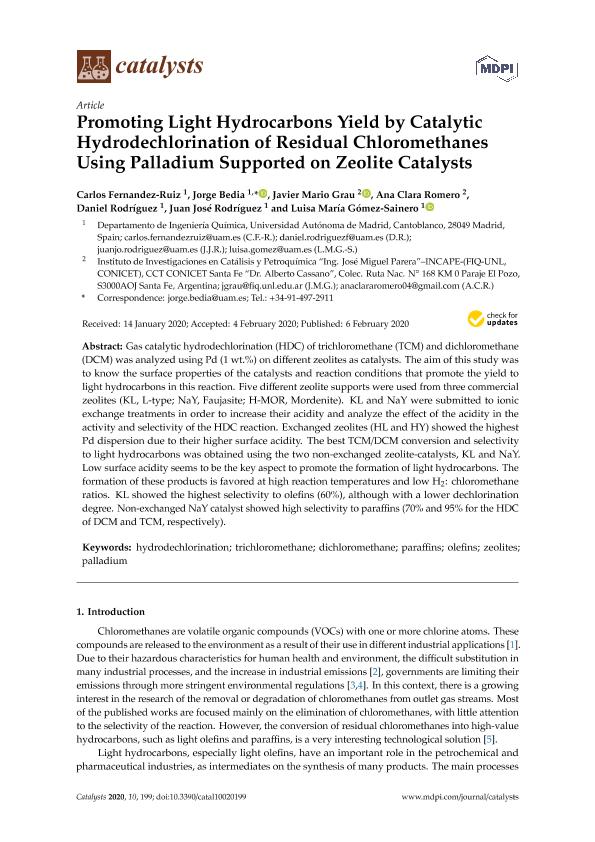Artículo
Promoting light hydrocarbons yield by catalytic hydrodechlorination of residual chloromethanes using palladium supported on zeolite catalysts
Fernandez Ruiz, Carlos; Bedia, Jorge; Grau, Javier Mario ; Romero, Ana Clara
; Romero, Ana Clara ; Rodríguez, Daniel; Rodríguez, Juan José; Gómez Sainero, Luisa María
; Rodríguez, Daniel; Rodríguez, Juan José; Gómez Sainero, Luisa María
 ; Romero, Ana Clara
; Romero, Ana Clara ; Rodríguez, Daniel; Rodríguez, Juan José; Gómez Sainero, Luisa María
; Rodríguez, Daniel; Rodríguez, Juan José; Gómez Sainero, Luisa María
Fecha de publicación:
02/2020
Editorial:
Molecular Diversity Preservation International
Revista:
Catalysts
ISSN:
2073-4344
Idioma:
Inglés
Tipo de recurso:
Artículo publicado
Clasificación temática:
Resumen
Gas catalytic hydrodechlorination (HDC) of trichloromethane (TCM) and dichloromethane (DCM) was analyzed using Pd (1 wt.%) on different zeolites as catalysts. The aim of this study was to know the surface properties of the catalysts and reaction conditions that promote the yield to light hydrocarbons in this reaction. Five different zeolite supports were used from three commercial zeolites (KL, L-type; NaY, Faujasite; H-MOR, Mordenite). KL and NaY were submitted to ionic exchange treatments in order to increase their acidity and analyze the effect of the acidity in the activity and selectivity of the HDC reaction. Exchanged zeolites (HL and HY) showed the highest Pd dispersion due to their higher surface acidity. The best TCM/DCM conversion and selectivity to light hydrocarbons was obtained using the two non-exchanged zeolite-catalysts, KL and NaY. Low surface acidity seems to be the key aspect to promote the formation of light hydrocarbons. The formation of these products is favored at high reaction temperatures and low H2:chloromethane ratios. KL showed the highest selectivity to olefins (60%), although with a lower dechlorination degree. Non-exchanged NaY catalyst showed high selectivity to paraffins (70% and 95% for the HDC of DCM and TCM, respectively).
Archivos asociados
Licencia
Identificadores
Colecciones
Articulos(INCAPE)
Articulos de INST.DE INVEST.EN CATALISIS Y PETROQUIMICA "ING. JOSE MIGUEL PARERA"
Articulos de INST.DE INVEST.EN CATALISIS Y PETROQUIMICA "ING. JOSE MIGUEL PARERA"
Citación
Fernandez Ruiz, Carlos; Bedia, Jorge; Grau, Javier Mario; Romero, Ana Clara; Rodríguez, Daniel; et al.; Promoting light hydrocarbons yield by catalytic hydrodechlorination of residual chloromethanes using palladium supported on zeolite catalysts; Molecular Diversity Preservation International; Catalysts; 10; 2; 2-2020; 1-18
Compartir
Altmétricas



